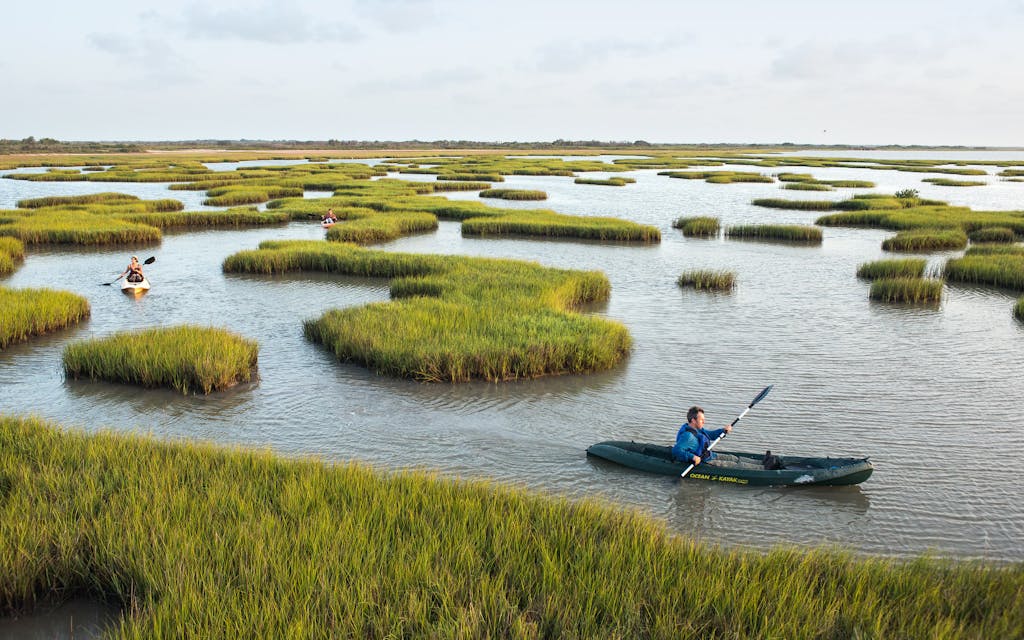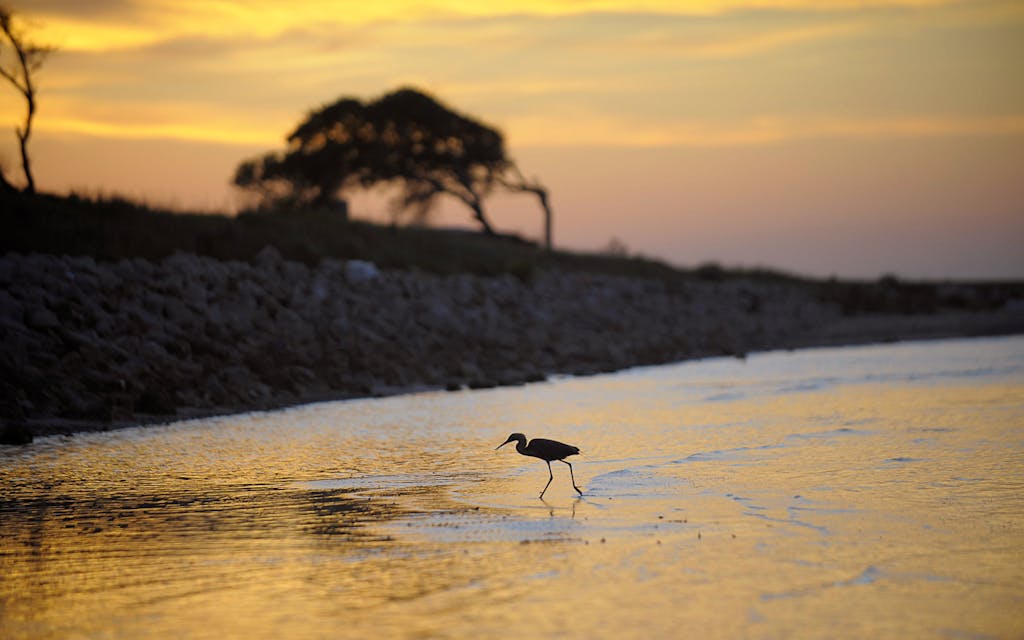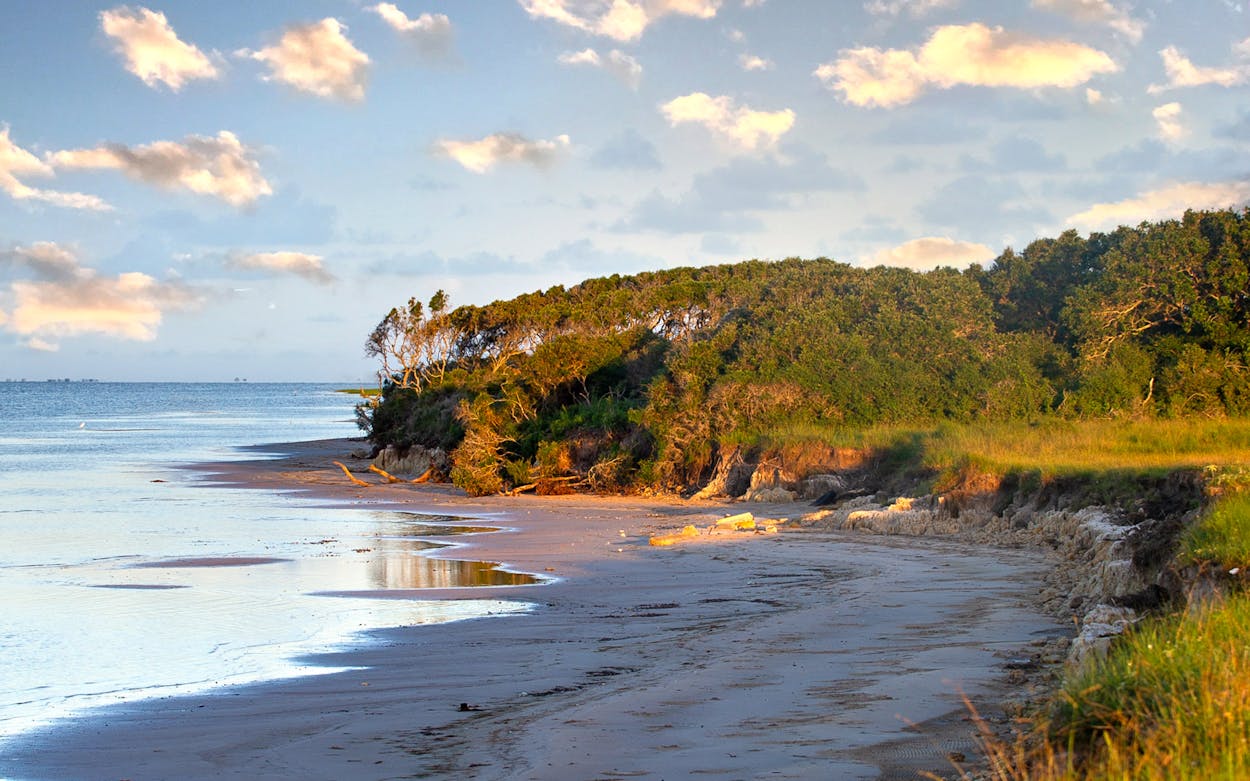I slide open the door of my camper van, which I’ve christened Vincent VanGo, and take in the view of Matagorda Bay shrouded in low, thick clouds the color of dryer lint. In front of me, a windswept tree bends low like a ballerina. Beyond it, a rust-colored barge glides past. At my back, a dirt road leads through a leafy tunnel into a thicket of old oaks. It’s cold, damp, and ruggedly beautiful here on Powderhorn Ranch, a sprawling chunk of coastal prairie and wetlands about twenty miles southeast of Port Lavaca that will one day become a state park for all Texans to enjoy.
No timeline has been set for the park’s opening, but it’s likely eight to ten years away. The nonprofit Texas Parks and Wildlife Foundation partnered with a coalition of conservation groups to buy the 17,351-acre cattle ranch from Tennessee landowner Brad Kelley in 2014. Kelley had purchased it from the family of Leroy G. Denman Sr., who had had it since 1936.
About 15,000 acres became the Powderhorn Wildlife Management Area. The last of the remaining 2,000-plus acres were transferred to the Texas Parks and Wildlife Department in October. Part of the funding for the $50 million project came from the National Fish and Wildlife Foundation’s Gulf Environmental Benefit Fund, established after the Deepwater Horizon oil spill; private donors also pitched in. The price tag includes $37.7 million for the land, plus about $12 million for habitat restoration and an endowment to fund the park’s long-term maintenance. At the time of the purchase, TPWD officials called it the largest dollar amount ever raised for a conservation land acquisition in Texas.

There’s still a long way to go before Powderhorn can open to the public. Parks and Wildlife officials must conduct surveys, hold open meetings to gather input, create a master plan, and identify more funding sources before they begin construction on any facilities. But on this chilly morning in late December, I’m getting a sneak peek from newly appointed superintendent Sarah Affeldt and TPWD regional director Reagan Faught.
They arrive just as I’m finishing my tea, and we bundle up and pile into an ATV for the tour. The parkland hugs the shoreline of Matagorda Bay to the east; to the north, it follows the edge of Powderhorn Lake, named in 1832 by a sailor who found a spoon and a powder horn—an animal horn used to hold gunpowder—on its banks. This is one of the largest undeveloped tracts of coastal prairie and wetlands left in the state.
“There aren’t many places along the Texas coast that feel as natural and untouched,” Affeldt says. “The history is ranching, but aside from that, it looks very similar to how it looked in the sixteen hundreds, when explorers first came to this area.”
Part of the ranch is peppered with “Mima mounds,” low, flattened mounds that rise a foot or two above their surroundings. Scientists aren’t sure what created them—among the many theories are gophers, windblown sediment, and earthquakes—but they’re confident humans weren’t involved. “The mounds provide evidence that this property was largely undeveloped over the last hundred fifty years,” Faught says. “From an ecology and conservation standpoint, that’s pretty big.”
The future park will provide urgently needed space for Texans to roam. The state’s population increased by about 15 percent, or nearly four million people, from 2010 to 2019. Park visitation also surged during the COVID-19 pandemic. Meanwhile, around 95 percent of Texas acreage is privately owned, leaving relatively little room for public recreation. “The population in Texas keeps growing and growing,” Faught says. “Our outdoor space hasn’t kept up.”
Thankfully, Powderhorn isn’t the only state park in the pipeline. Other sites awaiting development include Albert & Bessie Kronkosky State Natural Area, Chinati Mountains State Natural Area, Davis Hill State Park, and Palo Pinto Mountains State Park.

Officials envision Powderhorn as a destination for bird-watchers, hikers, anglers, and campers. Visitors might someday paddle canoes on the bay or in the lake and pitch tents along the shore or amid trees tucked farther inland.
We bounce over dirt roads, admiring rippling fields of bluestem grass. An osprey circles overhead. We spot a couple of sambar, a large species of deer native to Asia that rancher Leroy Denman Jr. introduced here decades ago for hunting. Parks and Wildlife officials plan to remove all the sambar, along with a population of axis deer, in part through public hunting opportunities beginning in 2022. Crews are also working to manage the running live oak—a short, scrubby, non-native species that thrives here—and restore much of the land to coastal grassland. That restoration will improve habitat for native birds and mammals, including the endangered whooping crane, which winters near here.
Around Powderhorn Lake, white pelicans and roseate spoonbills the color of Pepto Bismol have gathered. The park’s freshwater wetlands and salt marshes provide important habitat for fish and other wildlife, Faught says. They also offer humans protection from storm surges, as well as natural filtering that improves water quality by removing sediment and pollutants.
Before we finish our tour, we stop along the shoreline of the bay to take a closer look. Stretches of the bank have eroded, calving off into the choppy water. Wave action, storms, and passing ships have all taken their toll. “That is one of the biggest resource concerns—shoreline protection,” Faught says. Officials will have to reinforce the banks to stop the erosion.
Finally, we circle back toward the ranch’s restored camp house, which will one day serve as a visitors center. A decade from now, we won’t be the only ones taking in the view.
- More About:
- Port Lavaca






